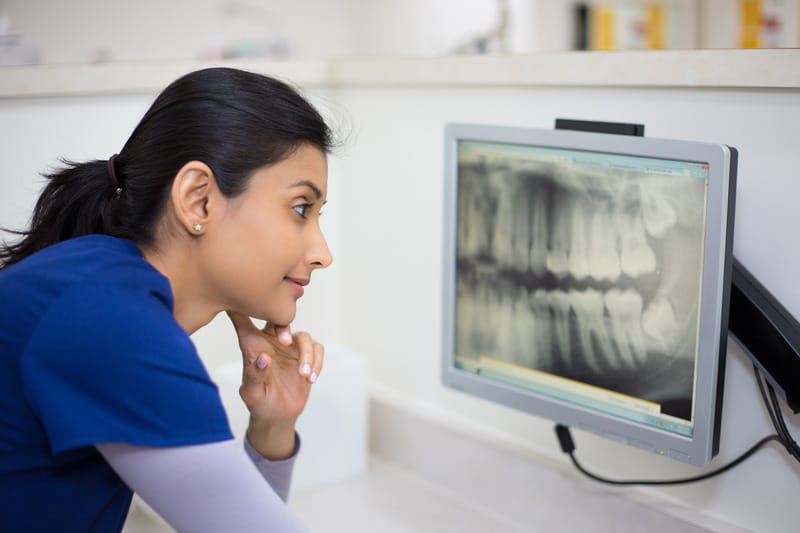

X-rays

X-Rays
Dental x-rays are images that can show cavities, gum disease, bone loss, and other problems that can’t be seen by just looking at the mouth. Dental X-rays are typically performed yearly. They can happen more often if your dentist is tracking the progress of a dental problem or treatment. There are different types of dental x-rays. A full-mouth series may be taken once every few years to check your oral health. Another type, called bitewing x-rays, may be used more often to check for cavities or other tooth problems.
What To Expect
During an x-ray, the dentist or hygienist will:
- Place a thick covering, called a lead apron, over your chest. These coverings protect the rest of your body from radiation. You may get an additional covering for your neck to protect your thyroid gland.
- Have you bite down on a small piece of plastic.
- Place a scanner outside your mouth. They will take a picture while standing behind a protective shield or another area.
- You will repeat this process for certain types of x-rays, biting down in different areas of your mouth, as instructed by the dentist or hygienist.
When the images are ready — instantly in the case of digital X-rays — your dentist will review them and check for abnormalities.
If a dental hygienist is cleaning your teeth, the dentist may go over the results of the X-rays with you after your cleaning is done. The exception is if the hygienist discovers any significant problems during the X-rays.
If your dentist finds problems, like cavities or tooth decay, they’ll discuss your treatment options. If your dentist finds no problems, keep up the good work!

Treatment plans are designed and determined on a case by case basis and no service is available “on demand”.
While dental X-rays do involve radiation, the exposed levels are so low that they’re considered generally safe for children and adults. If your dentist uses digital X-rays instead of developing them on film, your risks from radiation exposure are even lower.
Your dentist will also place a lead “bib” over your chest, abdomen, and pelvic region to prevent unnecessary radiation exposure to your vital organs. A thyroid collar may be used in the case of thyroid conditions. Children and women of childbearing age may also wear them with the lead bib.
Pregnancy is an exception to the rule. Women who are pregnant or believe they may be pregnant should avoid all X-rays. Tell your dentist if you think you’re pregnant because radiation is unsafe for developing fetuses.
Dental X-rays require no special preparation. The only thing you’ll want to do is brush your teeth before your appointment. That creates a more hygienic environment for those working inside your mouth. X-rays are usually done before cleanings.
At the dentist’s office, you’ll sit in a chair with a lead vest across your chest and lap. The X-ray machine is positioned alongside your head to record images of your mouth. Some dental practices have a separate room for X-rays, while others perform them in the same room as cleanings and other procedures.
There are several types of dental X-rays, which record slightly different views of your mouth. The most common are intraoral X-rays, like:
- Bitewing: This technique involves biting down on a special piece of paper so that your dentist can see how well the crowns of your teeth match up. This is commonly used to check for cavities between teeth (interdental).
- Occlusal: This X-ray is done when your jaw is closed to see how your upper and bottom teeth line up. It can also detect anatomical abnormalities with the floor of the mouth or the palate.
- Occlusal: This technique captures all of your teeth in one shot.
- Panoramic: For this type of X-ray, the machine rotates around the head. Your dentist may use this technique to check your wisdom teeth, plan for implanted dental devices, or investigate jaw problems.
- Periapical: This technique focuses on two complete teeth from root to crown.
- ExtraoralX-rays may be used when your dentist suspects there might be problems in areas outside of the gums and teeth, like the jaw.
A dental hygienist will guide you through each step of the X-ray process. They might step outside of the room briefly while the images are being taken. You’ll be instructed to hold still while the pictures are recorded. Spacers (film holders), if they’re used, will be moved and adjusted in your mouth to obtain the proper images.